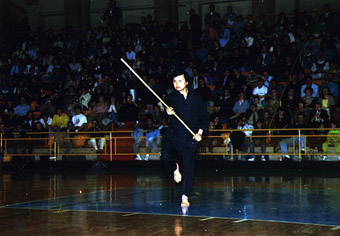
|
The name of Binh Dinh style comes from the homonymous region of
Central Vietnam, now called
Nghia Binh, located behind of the port of Qui Nhon.
Binh Dinh is one of the most famous Vietnamese style, mostly diffused in
Central and south Vietnam. Its birth is strictly bound to the historical
events that characterized the country at the end of the XVIII century.
|
In the second half of 1700, Vietnam, nominally governed by Le dynasty, was practically under control of two "feudal" seigniory, the Trinh in North and the Nguyen in Central-South. According to the tradition, the origin of the Binh Dinh style is in the events that involved three sons: Nguyen Nhac, Nguyen Lu and Nguyen Hue; they started a rebellion in 1771, called "Tay Son", from the name of the native village of the three sons. Initially it was a popular rebellion, caused by the desperate life conditions of the peasants under the administration of Nguyen; but it eventually extended to all the country, involving a great part of the population. In 1783 prince Nguyen Anh was compelled to escape and in 1786 Thang Long (Hanoi), stronghold of Trinh in North Vietnam, was occupied. The 'Le' dynasty, taking advantage from the weakening of Trinh and Nguyen control over the country, tried to regain the effective power and pressed the presence of the Chinese army. The younger of the three sons, Nguyen Hue, considered the father of the Binh Dinh style and one of the best strategist of that age, in 1788 proclaim himself emperor with the name of Quang Trung and refused the occupation, in north Vietnam, by the Chinese troops, came to support the 'Le' dynasty.
In many schools, Binh Dinh style is taught with other Vietnamese and chinese-vietnamese
styles. In central-south Vietnam there are different traditional schools of this style,
including the Sa Long Cuong school (the dragon that lies on sand dunes), in
which also the Thieu Lam (Shaolin) style is taught, the Bach Ho (
"white tiger") school and Ngu Ho ("five tigers") school.
In Binh Dinh region there are two districts: An Thai and An Nhon, whose schools are
famous for a secular mutual rivalry.
There are big differences between all schools, as Binh Dinh is a heterogeneous style,
with contaminations and different interpretations, due to the oral transmission of the
description of the quyen (forms) in form of
"poetry", corresponding to very
complex sequences of techniques.
The Binh Dinh style develop in a defined historical context and its characteristics
come from the conflict with Chinese army, constituted by soldier taller and more robust
than the Vietnamese ones. So, the strategy of this style is based on the principle of
opposition; short distance against long distance, fluency and flexibility against
hardness, mobility against staticity.
After the death of Quang Trung and the return of Nguyen Anh (1802), in Binh Dinh region,
there was the imposition of laws that limited the right of reunion and prohibited the
practice of martial arts. Toward this device there was the evolution of a peculiar
weapon of the Binh Dinh style, Roi stick (called "mouse tail"), a long stick that is
thinner at one of the two extremities. This weapon, because of its shape and flexibility,
allow to perform some techniques that are half-way between the lance ones and long
stick ones.
The program of Binh Dinh include ten quyen (forms) with open hands,
which name is often referred to the historical tradition
(Than Dong = "child king of heaven", legendary hero of the Vietnamese epic),
to the oriental philosophy (Bat Quai = 8 trigrams) or to the vegetal and animal world
(Long Ho = dragon and tiger, Lao Mai = the old plum-tree).
In addition to the quyen with open hands, the program include many forms with long
stick (Con) and with Roi stick, the butterfly-sward (Dao), the lance (Thuong) and the
Vietnamese sabre (Kiem or Guom).